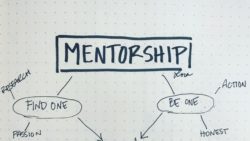What was I thinking?
This month’s ArchiTalks topic “What was I thinking” could go so many directions: What was I thinking, taking on yet another unpaid task? What was I thinking, saying yes to help that group when I’m 2 months behind on something else? What was I thinking when I made that note to myself? What was I thinking, detailing that roof that way?
Note: This is the thirty-seventh post in a group series called #ArchiTalks. This month’s topic is “What was I thinking?”

As an architect juggling too many things, my last month transitioned from feeling like I was losing a game of juggling plates to instead juggling angry porcupines. “What was I thinking” was becoming a recurring question either out of frustration at myself or decision amnesia. At a point of mental/physical overload, it starts to hurt a little (hence the porcupines). This could easily be a blog about that, and the importance of self-care, but instead I want to talk about something that I see as tantamount to our profession: our value.
But first, let’s talk about the phrase before “What was I thinking”:
“It looks so easy”
*groan*
“It looks so easy” is a very broad and generalized misunderstanding of what is actually a collective sum of many years of school and continual learning since then. “It looks so easy” is like not being able to see the forest for the trees and not understanding all of the things an architect thought about to get to the decision that was made as a part of the process of solving your design problem.
But that’s not your fault as a client, it’s mine/ours as an architect. I need to show you behind the curtain, the “what was I thinking” so that you see the value I bring to a project and can better grasp all the things I’m thinking about when I detail out a space for you. The problems I solved that you *might not have known you had* will similarly go unnoticed if I don’t take care to show you what I was thinking as I laid out the details of a room.
As with most creative fields, there will always be a piece of “it looks so easy” that is the ungraspable, unexplainable idea that comes to a creator, but so much of what an architect does is explained through a process of solving a problem…from the big vague box of an idea down to the minute detail of the bedroom bulkhead. What was I thinking during a design? Well, let’s talk about it…and talk about *why* we need to talk about it more often.
What was I thinking?
Austin Kleon has a book called “Show Your Work” that speaks to this topic well. It gets into more of the depths of how/why/where to show your work, but I want to dial back and focus on the why (I recommend buying a copy and reading all the other bits, too, though). Walking a teammate, a boss, or a client through what you were thinking gives opportunities to learn, share knowledge, and ultimately show your value. Let’s look at each of these:
1. Learn
Keeping all of your work to yourself until the final submission is the worst kind of echo chamber. Fortunately, most schools require interim crits and instill this searching and sharing of knowledge from early on, but there are still some architects who would rather not talk about what they’re doing, like it’s a secret patent for NASA. I don’t get it. Unless you’re literally patenting a project detail, not talking about what you’re doing on a project removes your ability to learn from others who may have experience with a specific detail or material. You may miss out on learning a way to note a section to improve the chances that all of the thermal breaks are caught during construction. When you don’t share what you’re thinking or the steps to and through your design – just like that old math homework that said SHOW YOUR WORK – you lose the opportunity to learn that you were 90% right but your idea went astray because you didn’t quite understand the tolerances for a connection.
2. Share knowledge
Similar to learning, not sharing what you were thinking makes it hard to teach and mentor others, to share knowledge.
Doing math in your head is fine, but telling someone they’re doing a detail wrong without showing them a better way is like…well, you know, I can’t think of any good analogy right now because it just plain sucks. You learned from people before you, who shared what they were thinking. Now it’s your turn. And sharing knowledge doesn’t have an age requirement, FYI. So just do it already. Talk through what you’re thinking.
You never know who is watching or listening, through all the variety of mediums we have to communicate at our disposal, and might be looking to you as a mentor. Or might simply come across your tweet, the article you shared, or a sketch and learn something new. Or better yet, learn something new and connect you as a source of knowledge and leader on that topic/in your profession. Which brings us to…
3. Show value
By sharing your process and saying “This is what I was thinking…”, you not only open yourself up to the opportunity to learn and share knowledge, but you also show your value and the breadth of understanding you bring to a topic. Not all clients understand that an architect has to know more than how to draw a pretty elevation, but also has to understand the type of window header for the specific wall, which is impacted by the aesthetic choices and the geographical location, which then has to be presented to a city or state agency for permitting, or potentially a historic commission that oversees the neighborhood where you’re building, and can also advise you on funding options or costs. And believe me, I didn’t touch on all of it. But just as I don’t understand what an Actuary does, the average person doesn’t know what an architect does. While I might be solving a problem for someone else that they don’t specifically have right now, talking it through with them or sharing a sketch online shows them my ability to problem-solve or a larger scope of what goes into doing so. It might make them realize that while they don’t have the problem I am talking about, they have another problem that I might be able to help them fix.
When you don’t take a down beat to say “This is what I was thinking”, everyone loses. You lose by closing yourself off from a learning opportunity. Your client loses because they weren’t given the opportunity to see where and how you came to a decision and perhaps guide you to a more correct use of a space instead of what you assumed from an initial meeting. Your potential boss (or you again) lose because all of this typically leads to a project of a lesser quality…which kind of means the client loses again.
What was I thinking? I was thinking about how much I love this profession and all of the smarty pants that I interact with. I was thinking about that detail I just learned from a coworker because I took the time to ask. I was thinking about the possibility that, by sharing what I was thinking via a sketch or a blog, someone else might learn from the lessons and challenges I’ve had to overcome – that their path might be easier because of it. I was thinking that a current or potential client will see me as a transparent and willing participant in the project of solving their problems. I was thinking about how showing my work online gives a glimpse, each time, to the varied things an architect can do, solve, dream up, or build.
What was I thinking? A lot. My hope is that we continue to think together.
To see the take on “What was I thinking” from other Architects, follow the links to the others in the #ArchiTalks group who are posting today on the theme:
- Cormac Phalen – Cormac Phalen (@archy_type) “What was I thinking?”
- James Mehaffey – Yeoman Architect (@jamesmehaffey) “What was I thinking”
- Eric Faulkner – Rock Talk (@wishingrockhome) “WWIT — Convenience Kills!”
- Michele Grace Hottel – Michele Grace Hottel, Architect (@mghottel) “what was i thinking?”
- Jeffrey Pelletier – Board & Vellum (@boardandvellum) “What Was I Thinking? (Learning from Your Mistakes When Starting a Business)”
- Brian Paletz – The Emerging Architect (@bpaletz) “What was I thinking?”
- Mark Stephens – Mark Stephens Architects (@architectmark) “What was I thinking!”
- Jeremiah Russell, AIA – ROGUE Architecture (@rogue_architect) “what were we thinking: #architalks”




